
| ||||
|---|---|---|---|---|
 |
 |
 |
 |
 |



























| ||||
|---|---|---|---|---|
 |
 |
 |
 |
 |


























Grumman A-6E Intruder
USN Twin-engine two-seat attack-bomber, USA
Archive Photos 1,2,3
Grumman A-6E Intruder (BuNo 161108) on display (c.1988) at the MCAS El Toro Airshow, MCAS El Toro, California (Photos by John Shupek)

Grumman A-6E Intruder (BuNo 159631) on display (c.1993) at the San Diego Aerospace Museum, Gillespie Field, El Cajon, California (Photos by John Shupek)

Grumman A-6E Intruder Salty Dog (BuNo 156997) on display (c.1998) at the Patuxent River Naval Aviation Museum, Lexington Park, Maryland (Photos by John Shupek)



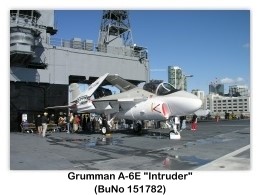
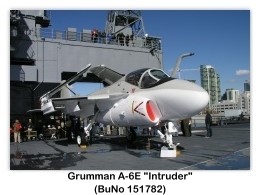
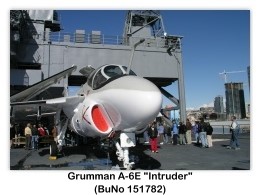

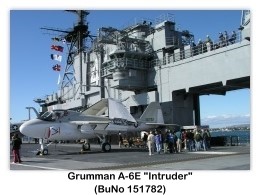
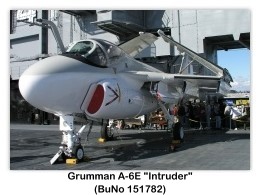
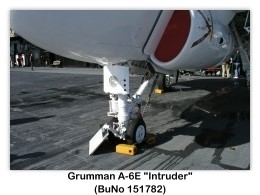
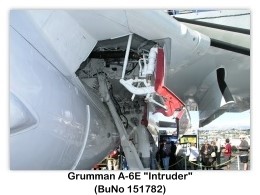
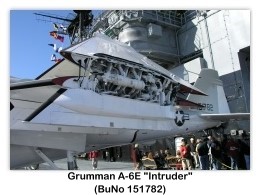

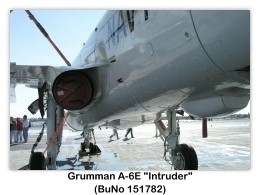
Grumman A-6E Intruder (BuNo 159610) on display (2/16/2004) at the National Air and Space Museum Steven F. Udvar-Hazy Center, Chantilly, Virginia (Photo by Jim Hough)

Grumman A-6A/E Intruder (BuNo 152936) on display (10/6/2012) at the The U.S. Naval Museum of Armament and Technology, NAWS China Lake, California (Photos by Peter S. Kuntz)




Overview 3
The Grumman A-6 Intruder is a Twin-engine, mid-wing attack aircraft built by Grumman Aerospace. In service between 1963 and 1997, the Intruder was designed as an all-weather replacement for the piston-engined Douglas A-1 Skyraider medium attack aircraft. A specialized electronic warfare derivative, the Grumman EA-6B Prowler, remains in service as of 2007. As the Grumman A-6 was slated for retirement, its precision strike mission was taken over by the now retired Grumman F-14 Tomcat equipped with LANTIRN, which has subsequently passed on the role to the Boeing F/A-18E/F Super Hornet.
Development 3
The Grumman Intruder was developed in response to a U.S. Navy specification for an all-weather carrier-based attack aircraft to serve as a replacement for the piston-powered, World War II-era Douglas A-1 Skyraider. Grumman was awarded the contract in 1957, and the resulting Grumman A2F-1 Intruder made its first flight on April 19, 1960. The jet nozzles were originally designed to swivel downwards, but this was dropped from production aircraft. The pilot sits in the left seat, while the bombardier/navigator sits to the right and below. A unique CRT gives a synthetic display of terrain ahead which, with the additional crew member, enabled low-level flying in all weather conditions. The wing is very efficient at subsonic speeds compared to supersonic fighters such as the McDonnell Douglas F-4 Phantom II, which are also limited to subsonic speeds when carrying a payload of iron bombs. A very similar wing would be put on pivots on Grumman’s later supersonic swing-wing F-14 Tomcat, as well as similar landing gear.
Operational History 3
The Grumman Intruder received a new standardized DOD designation of A-6A in the fall of 1962, and entered squadron service in February 1963. The Grumman A-6 Intruder became the USN and USMC’s principal medium and all-weather/night attack aircraft from the mid-1960s through the 1990s and as an aerial tanker either in the dedicated Grumman KA-6D version or by use of a buddy store (D-704). This role was served in the USAF by the Republic F-105 Thunderchief and later General Dynamics F-111 Aardvark which was also later converted to a radar jammer as the General Dynamics EF-111 Raven. The Grumman A-6 Intruder first saw combat in Vietnam and in later engagements in Lebanon and Libya. The Grumman A-6 Intruder saw further duty during Operation Desert Storm in 1991, as well as over Bosnia in 1994, but it was phased out of service quickly in the mid-1990s in a Navy move to reduce the Type/Model/Series aircraft in the carrier airwing. It was intended for replacement by the McDonnell Douglas A-12 Avenger II, but that program was canceled. The Grumman A-6 Intruder was left to soldier on for a few more years before retiring in favor of the LANTIRN equipped Grumman F-14 Tomcat, which was in turn replaced by the McDonnell Douglas F/A-18E/F Super Hornet. Many questioned the shift to a shorter ranged strike force compared to the older generation planes. However, the availability of USAF tanking assets in all recent conflicts put a lesser premium on self contained range.
Grumman A-6 Intruders first saw action during the Vietnam War, where the craft were used extensively against targets in Vietnam. The aircraft’s long range and heavy payload of 18,000 lb (8,170 kg) coupled with its ability to fly in all weather made it invaluable during the war. However, its effectiveness in flying low and delivering its payload made it especially vulnerable to anti-aircraft fire and in the eight years the Grumman A-6 Intruder was used, the U.S. Navy and Marines lost 84 Intruders to all causes during the Vietnam War. The first loss occurred on 14 July 1965 when a Grumman A-6 Intruder from VA-75, flown by LT Donald Boecker and LT Donald Eaton, from the carrier USS Independence commenced a dive on a target near Laos. An explosion under the starboard wing damaged the starboard engine, causing the aircraft to catch fire, and the hydraulics to fail. Seconds later the port engine failed, the controls froze, and the two crewmen ejected. Both crewmen survived. On 21 August 1967 four Grumman A-6 Intruders from the carrier USS Constellation (Squadron VA-196) attacked a railway in North Vietnam, one A-6 piloted by Cdr Leo Profilet and Lcdr William Hardman was hit by a surface to air missile (SAM), their aircraft cart wheeled, and both crewmen ejected, becoming POWs. The three other Grumman A-6 Intruders continued their mission, then suddenly two of the three Grumman A-6 Intruders became separated from the third aircraft, and possibly due to the thunderstorms and low clouds, headed directly across into Communist China. They were attacked and shot down by Red Chinese MiG-19 Farmers (J-6s). LTs(JG) Dain Scott and Forrest Trembley, and LCDR Jimmy Buckley did not survive. LT Robert Flynn became a POW, and was repatriated on 15 March 1973. Of the 84 Grumman A-6 Intruders lost to all causes during the war, 10 were shot down by surface to air missiles (SAM’s), 2 were shot down by MiG’s, 16 were lost to operational causes, and 56 were lost to conventional ground fire and AAA. Most U.S. Marine Corps Grumman A-6 Intruders were shore based in South Vietnam at Chu Lai and Da Nang. The last Grumman A-6 Intruder to be lost during the war was from Squadron VA-35, flown by LTs C. M. Graf and S. H. Hatfield, from the carrier USS America — they were shot down by ground fire on 24 January 1973 while providing close air support. The airmen ejected and were rescued by a Navy helicopter. Twenty U.S. Navy aircraft carriers rotated through the waters of Southeast Asia, providing air-strikes, from the early 1960s through the early 1970s. Nine of those carriers lost Grumman A-6 Intruders: USS Constellation lost 11, USS Ranger lost 8, USS Coral Sea lost 6, USS Midway lost 2, USS Independence lost 4, USS Kitty Hawk lost 14, USS Saratoga lost 3, USS Enterprise lost 8, and USS America lost 2.
Grumman A-6 Intruders were later used in support of other operations, such as the International forces in Lebanon 1983. One Grumman A-6 Intruder and one LTV A-7 Corsair II were downed by Syrian missiles on December 4, 1983. Grumman A-6 Intruders also saw action operating from the aircraft carriers USS America and USS Coral Sea during Operation El Dorado Canyon in April 1986. The squadrons involved were VA-34 Blue Blasters (from USS America) and VA-55 Warhorses (from USS Coral Sea). Grumman A-6 Intruders saw extensive action in Operation Desert Storm where they were the Navy’s primary strike platform for delivering laser-guided bombs. The U.S. Navy operated them from the aircraft carriers USS Saratoga, USS John. F Kennedy, USS Midway, USS Ranger, USS America, and USS Theodore Roosevelt. The U.S. Marine Corps also operated two land-based squadrons of Grumman A-6E Intruders during the conflict.
Following Operation Desert Storm, Grumman A-6 Intruders were used to patrol the no-fly zone in Iraq and provided air support for Marines during Operation Restore Hope in Somalia. The last Grumman A-6E Intruder left Marine Corps service on 28 April 1993. The Grumman A-6 Intruder’s large blunt nose and slender tail inspired a number of nicknames, including Double Ugly, The Mighty Alpha Six, Iron Tadpole and also Drumstick.
The last Grumman A-6 Intruders were retired 28 February 1997. A number of retired Grumman A-6 Intruder airframes were sunk off the coast of St. Johns County, Florida to form a fish haven entitled Intruder Reef. However, contrary to popular belief, surviving aircraft fitted with the new wings were stored at the AMARC storage center at Davis-Monthan Air Force Base, and not sunk as artificial reefs. Although the Grumman A-6 Intruder could not match the McDonnell Douglas F/A-18 Hornet’s speed or air-combat capability, the Grumman A-6 Intruder’s range and load-carrying ability are still unmatched by newer aircraft in the fleet.
Variants 3
Attack Variants
YA-6A: This designation was given to eight prototypes and pre-production aircraft, used in the development of the A-6A Intruder.
A-6A: The initial version of the Intruder was built around the complex and advanced DIANE (Digital Integrated Attack/Navigation Equipment), intended to provide a high degree of bombing accuracy even at night and in poor weather. DIANE consisted of multiple radar systems: the Norden AN/APQ-92 search radar and a separate AN/APQ-112 for tracking, AN/APN-141 radar altimeter, and AN/APN-153 Doppler to provide position updates to the AN/ASN-31 inertial navigation system. An air-data computer and ballistics computer integrated the radar information for the bombardier/navigator (BN) in the right-hand seat. TACAN and ADF were also provided for navigational use. When it worked, DIANE was perhaps the most capable nav/attack system of its era, giving the Intruder the ability to fly and fight in even very poor conditions (particularly important over Vietnam and Thailand during the Vietnam War). It suffered numerous teething problems, though, and it was several years before its reliability was established. The total Grumman A-6A Intruder production was 488, including six pre-production prototypes. Many of the surviving aircraft were converted to other variants.
A-6B: To provide Navy squadrons with a SEAD aircraft to attack enemy air defense and SAM systems — a mission dubbed Iron Hand in Navy parlance — 19 Grumman A-6A Intruders were converted to Grumman A-6B Intruder standard from 1967 to 1970. The Grumman A-6B Intruder had many of its standard attack systems removed in favor of special equipment to detect and track enemy radar sites and to guide AGM-45 Shrike and AGM-78 Standard anti-radiation missiles. Five were lost in combat, and the rest were later converted to Grumman A-6E Intruder standard in the late 1970s.
A-6C: 12 Grumman A-6A Intruders were converted in 1970 to Grumman A-6C Intruder standard for night attack missions against the Ho Chi Minh Trail in Vietnam. They were fitted with a TRIM (Trails/Roads Interdiction Multi-sensor) pod in the fuselage for FLIR and low-light TV cameras, as well as a Black Crow engine ignition detection system. One of these aircraft was lost in combat, the others were later converted to Grumman A-6E Intruder standard after the war.
KA-6D: In the early 1970s some 78 Grumman A-6A Intruders and 12 Grumman A-6E Intruders were converted for use as tanker aircraft, providing aerial refueling support to other strike aircraft. The DIANE system was removed and an internal refueling system was added, sometimes supplemented by a D-704 refueling pod on the centerline pylon. The Grumman KA-6D Intruder theoretically could be used in the day/visual bombing role, but it apparently never was, with the standard load-out being four fuel tanks. Because it was based on a tactical aircraft platform, the Grumman KA-6D Intruder provided a capability for mission tanking — the ability to keep up with strike packages and refuel them in the course of a mission. A few Grumman KA-6D Intruders went to sea with each Intruder squadron, and the retirement of the aircraft left a gap in USN and USMC refueling tanker capability. The USN Lockheed S-3 Viking also has an aerial refueling capability, but its performance and fuel capacity effectively limit it to the role of recovery tanker. The loss of mission tanking capability was only later remedied by the new McDonnell Douglas F/A-18E Super Hornet, which can act as a mission tanker.
A-6E: The definitive attack version of the Intruder, introduced in 1970, with its first deployment 9 December 1971, with vastly upgraded nav/attack systems. The original search and track radars of the Grumman A-6A Intruder were replaced by a single AN/APQ-148 Norden multi-mode radar, and the onboard computers with a more sophisticated solid-state electronic system. A new AN/ASN-92 inertial navigation system was added, along with the CAINS (Carrier Aircraft Inertial Navigation System), for greater navigation accuracy. Beginning in 1979 all Grumman A-6E Intruders were fitted with the AN/AAS-33 DRS (Detecting and Ranging Set), part of the TRAM (Target Recognition and Attack, Multi-Sensor) system, a small, gyroscopically stabilized turret, mounted under the nose of the aircraft, containing FLIR bore-sighted with a laser spot-tracker/designator. TRAM was matched with a new AN/APQ-156 Norden radar. The BN could use both TRAM imagery and radar data for extremely accurate attacks, or use the TRAM sensors alone to attack without using the Intruder’s radar (which might warn the target). TRAM also allowed the Intruder to autonomously designate and drop laser-guided bombs. In addition, the Intruder used AMTI (Airborne Moving Target Indicator) which allowed the plane to track a moving target and drop ordnance on it even though the target was moving. Also, the computer system allowed the use of Offset Aim Point (OAP), giving the crew the ability to drop on a target unseen on radar by noting coordinates of a known target nearby and entering the offset range and bearing to the unseen target.
In the early 1990s some surviving Grumman A-6E Intruders were upgraded under SWIP (Systems/Weapons Improvement Program) to enable them to use the latest precision-guided munitions, including AGM-65 Maverick, AGM-84 Harpoon, AGM-84E SLAM, AGM-62 Walleye and the AGM-88 HARM anti-radiation missile.
After a series of wing-fatigue problems, about 85% of the fleet was fitted with new graphite/epoxy/titanium/aluminum composite wings. Grumman A-6E models totaled 445 aircraft, about 240 of which were converted from earlier A-6A/B/C models.
A-6F and A-6G: An advanced Grumman A-6F Intruder II was proposed in the mid-1980s that would have replaced the Intruder’s elderly Pratt & Whitney J52 turbojets with non-afterburning versions of the General Electric F404 turbofan used in the McDonnell Douglas F/A-18 Hornet, providing substantial improvements in both power and fuel economy. The Grumman A-6F Intruder II would have had totally new avionics, including a Norden AN/APQ-173 synthetic aperture radar and multi-function cockpit displays — the APQ-173 would have given the Intruder air-to-air capacity with provision for the AIM-120 AMRAAM. Two additional wing pylons were added, for a total of seven stations. Although five development aircraft were built, the Navy ultimately chose not to authorize the Grumman A-6F Intruder II, preferring to concentrate on the McDonnell Douglas A-12 Avenger II. This left the service in a quandary when the McDonnell Douglas A-12 Avenger II was canceled in 1991. Grumman proposed a cheaper alternative in the A-6G, which had most of the A-6F’s advanced electronics, but retained the existing engines. This, too, was canceled.
Electronic Warfare Versions
An electronic warfare/ECM version of the Grumman A-6 Intruder was developed early in the aircraft’s life for the USMC, which needed a new ECM platform to replace its elderly Douglas F3D-2Q Skyknights. An EW version of the Grumman Intruder, initially designated A2F-1Q and subsequently redesignated EA-6A, first flew on 26 April 1963. It had a Bunker-Ramo AN/ALQ-86 ECM suite, with most electronics contained on the walnut-shaped pod atop the vertical fin. They were theoretically capable of firing the AGM-45 Shrike anti-radiation missile, although they were apparently not used in that role.
Only 28 Grumman EA-6A’s were built (two prototypes, 15 new-build, and 11 conversions from Grumman A-6A Intruders), serving with Marine Corps squadrons in Vietnam. It was phased out of front-line service in the mid-1970s, remaining in use in reserve units with the USMC and then the US Navy primarily for training purposes. The last had been retired completely by 1993.
A much more highly specialized derivative of the Intruder was the Grumman EA-6B Prowler, a ‘stretched’ airframe with two additional systems operators, and more comprehensive systems for the electronic warfare and SEAD roles. In total, 170 were produced. The Grumman EA-6B Prowler remains in service as of 2006, replacing the Air Force General Dynamics EF-111 Ravens aka Spark Vark when the DOD decided to let the Navy handle all electronic warfare missions. It is scheduled to be replaced by the McDonnell Douglas EA-18G Growler Super Hornet variant.
NA-6A: The redesignation of three Grumman YA-6A Intruders and three Grumman A-6A Intruders. The six aircraft were modified for special tests.
YEA-6A: One Grumman YA-6A Intruder aircraft was converted into the Grumman EA-6A prototype.
YEA-6B: The designation of two Grumman EA-6B Prowler prototypes, which were modified for special test purposes.
NEA-6A: One Grumman EA-6A aircraft was modified for special test purposes.
Specifications (A-6E) 4
General Characteristics
Performance
Armament
References